In a number of studies we’ve asked participants to indicate their sexual orientation. Recognizing that for many people sexual orientation is complex and difficult to plot on a single dimension, we have over time provided additional options (i.e., asexual, pansexual), or changed the way we presented the question to allow more nuanced responses.1 The result of this change was illuminating. In a recent study, we moved from a traditional 7-point Kinsey scale to a simple, categorical approach, giving participants several options to choose from. 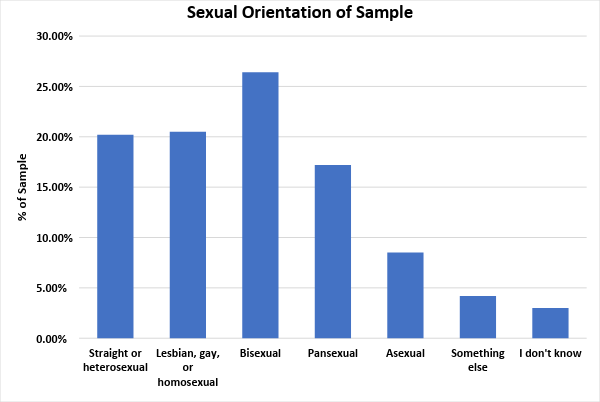 In prior studies, heterosexuality, while never a majority, was always the most commonly chosen option. When participants were able to chose labels, bisexuality emerged as the most frequent sexual orientation, with only about 20% of furries self-identifying as heterosexual. It is also worth noting that other orientations, such as asexuality, emerged as fairly prominent in the fandom, with about 1 in 11 furries identifying as such. In prior studies2 we’ve asked participants to indicate their sexual orientation using a 7-point scale adapted from a traditional Kinsey scale, ranging from “exclusively heterosexual” to “exclusively homosexual” along a single dimension.3 Recognizing that many people do not consider their sexual identity to fall within this single dimension, we provided additional options (i.e., asexual, pansexual, and an option to write in their own option). It should be noted that many of the following analyses using two or more variables, the analyses often require continuous variables and, in such instances, only the data from the 1-7 scale is used. This is not a statement about alternative sexual orientations, but rather, is a byproduct of the type of analysis used and, wherever possible, we present data on other sexual orientations. In some instances, rarer sexual orientations are presented as an aggregate “other” category to protect the identity of those who may otherwise be identifiable for having provided a unique or rare response.
In prior studies, heterosexuality, while never a majority, was always the most commonly chosen option. When participants were able to chose labels, bisexuality emerged as the most frequent sexual orientation, with only about 20% of furries self-identifying as heterosexual. It is also worth noting that other orientations, such as asexuality, emerged as fairly prominent in the fandom, with about 1 in 11 furries identifying as such. In prior studies2 we’ve asked participants to indicate their sexual orientation using a 7-point scale adapted from a traditional Kinsey scale, ranging from “exclusively heterosexual” to “exclusively homosexual” along a single dimension.3 Recognizing that many people do not consider their sexual identity to fall within this single dimension, we provided additional options (i.e., asexual, pansexual, and an option to write in their own option). It should be noted that many of the following analyses using two or more variables, the analyses often require continuous variables and, in such instances, only the data from the 1-7 scale is used. This is not a statement about alternative sexual orientations, but rather, is a byproduct of the type of analysis used and, wherever possible, we present data on other sexual orientations. In some instances, rarer sexual orientations are presented as an aggregate “other” category to protect the identity of those who may otherwise be identifiable for having provided a unique or rare response.
The data in the figure below represent the responses of furries and a non-furry sample of the general American population on the 7-item sexual orientation dimension. In these studies, furries were far less likely to report being exclusively heterosexual than the general population (wherein 90% reported predominantly or exclusively heterosexual as their orientation).4 Furries were approximately 7 times more likely to be predominantly or exclusively homosexual. Not shown in the figure, furries were more likely to report “other” as their sexual orientation (15.0% vs. 2.4%), which included pansexual, asexual, and a variety of self-provided orientations). To summarize, furries are far more likely to be non-heterosexual than non-furries, though it would be inaccurate to characterize the furry fandom as homosexual, as the most frequently-occurring single sexual orientation among furries is still “exclusively heterosexual.”

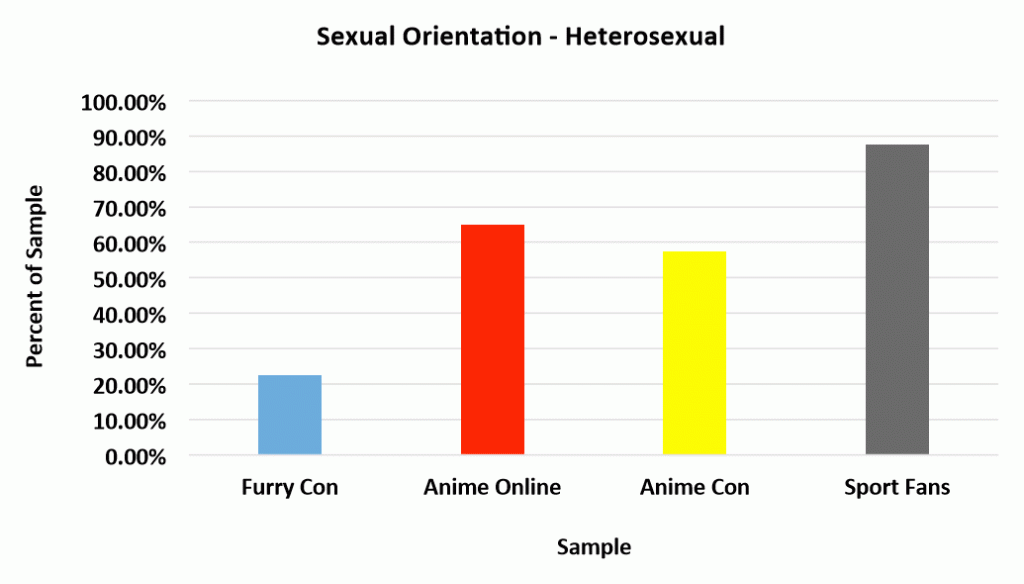
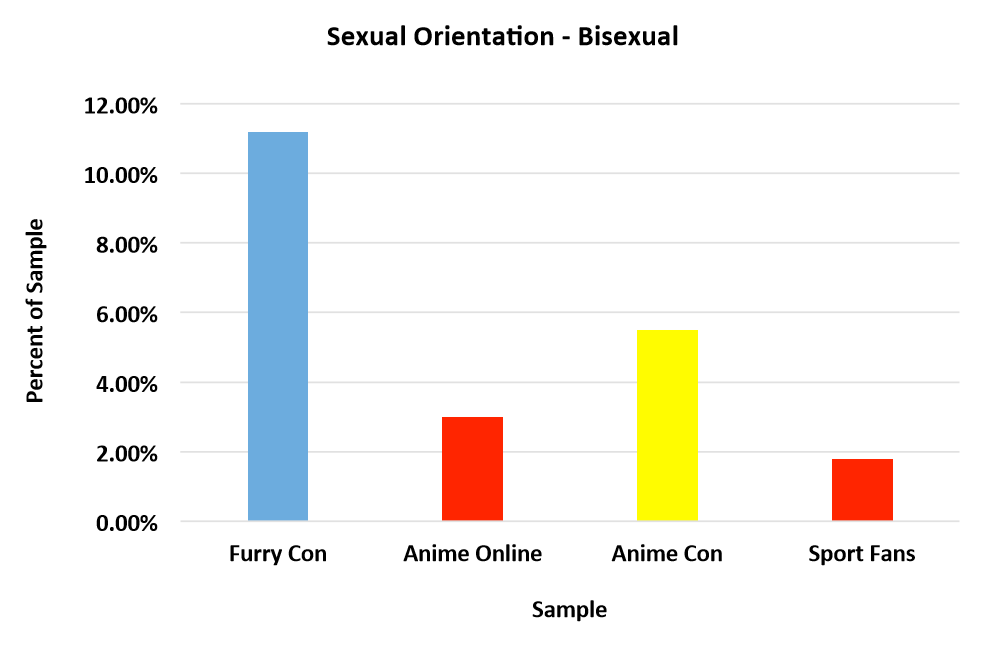
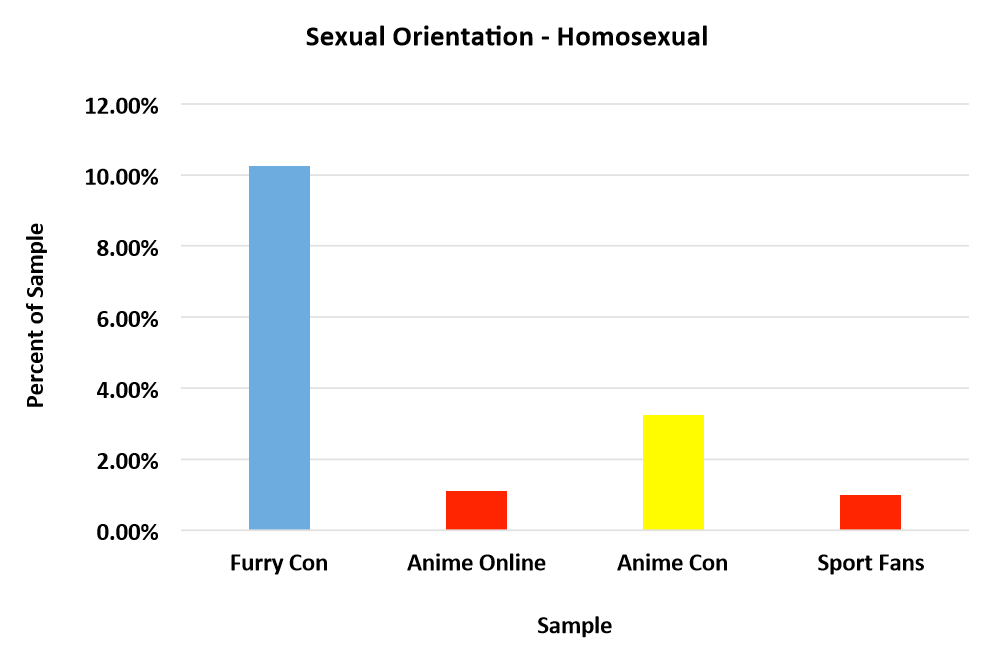
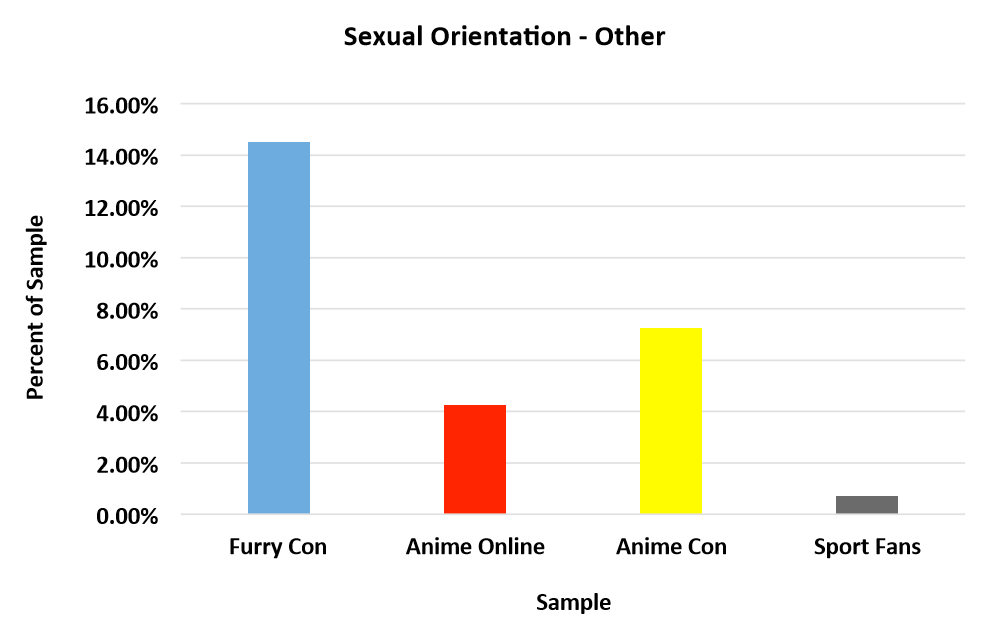
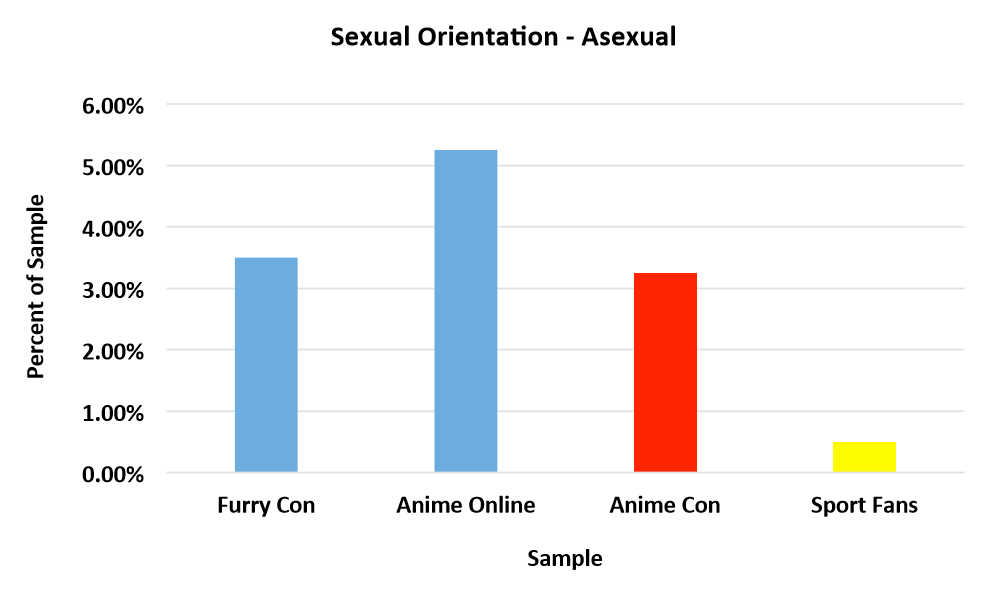
In a final analysis, the fan groups differed in the nature of the relationship between sexual orientation and sex (that is, people assigned “male” or “female” at birth). In the fantasy sport group and both anime fan groups, females were more likely than males to self-identify as homosexual (as indicated by higher numbers on the sexual orientation scale). In contrast, in the furry fandom, males—not females—were more likely to self-identify as non-heterosexual.
Given that only about 20-30% of furries self-identify as exclusively or predominantly heterosexual, it may be possible that they construe themselves as a minority within the furry fandom. Anecdotal evidence suggests that some heterosexual furries may feel stigmatized or ostracized within the furry fandom as a result of this minority status. Alternatively, it may also be the case that members of other traditionally minority sexual orientations (e.g., lesbian, gay, bisexual, queer persons) may nevertheless feel stigmatized within the fandom because they, too, constitute minorities within the fandom.
To test both of these possibilities, we asked furries whether they believed that straight and LGBQ people were accepted within the furry fandom (as separate questions).7
In line with our asking of an analogous question about gender diverse people within the fandom,8 we then compared the responses of straight and LGBQ participants to these questions. Analyses revealed that the two groups did not differ with regard to either question: both groups strongly agreed that both straight and LGBQ persons were accepted within the furry fandom, although both groups did more strongly agree with this notion with regard to LGBQ people (6.48 / 7.00) as compared to straight people (6.14 / 7.00). In a later study 9 participants were given a series of questions about acceptance of various sexual orientations within the fandom, and asked to both guess the extent to which the average furry was accepting of each sexual orientation within the fandom, and then to provide their own rated acceptance of each orientation. The data reveal two interesting trends. First, furries’ actual rates of acceptance were considerably higher than predicted. Put another way, furries expect the average furry to be less tolerant of other sexual orientations than they, themselves, are – furries underestimate the tolerance of other furries. Second, and perhaps even more interesting, this effect seems to be largest with respect to asexuality and heterosexuality: Furries believe that other furries are somewhat less tolerant of asexual and heterosexual people in the fandom, despite furries being virtually identical in their actual acceptance of all sexual orientations in the fandom. These data go against the often-held belief among some in the fandom that straight furries are not accepted or are unwelcome in the furry fandom. 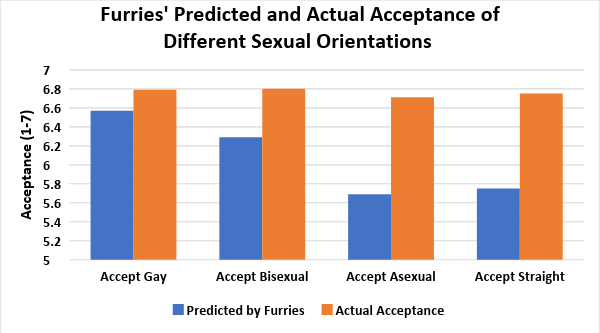 Additionally, we conducted a series of analyses aimed at testing whether there were measurable differences between straight furries and non-straight (e.g., asexual, gay, bisexual, pansexual) furries on a number of different variables. 10 The results of these analyses are as follows (keeping in mind that these are only average tendencies, and do not reflect differences for all straight / non-straight furries):
Additionally, we conducted a series of analyses aimed at testing whether there were measurable differences between straight furries and non-straight (e.g., asexual, gay, bisexual, pansexual) furries on a number of different variables. 10 The results of these analyses are as follows (keeping in mind that these are only average tendencies, and do not reflect differences for all straight / non-straight furries):
| They do not differ on… | Non-straight furries… |
| – How long they’ve been in the fandom | – Identify more strongly as furries, with other furries, and with their fursonas |
| – How “open” they are about being furry | – Are less likely to have a “predator” fursona |
| – How much they engage in harmful forms of fantasy (e.g., delusion, excess) | – Engage in more “positive” forms of fantasy |
| – How likely they are to have been diagnosed with autism | – Have a stronger bond with animals |
| – Their satisfaction with their current relationship status | – Are more likely to consider furry a fetish |
| – Their social skills / having problems with social interaction | – Score lower on measures of psychological well-being |
| – Their belief that the furry fandom accept gay, straight or bisexual people | – Believe that furries are less accepting of asexual people in the fandom |
In short, evidence suggests that, in general, people are accepted in the furry fandom regardless of their sexual orientation. While there is sometimes the perception that members of the LGBTQ community are the most strongly accepted members of the fandom, evidence suggests that, while there are indeed significant differences between the straight and non-straight members of the fandom, furries are generally accepted and welcomed within the community regardless of orientation. It may also be the case that the openness and acceptance of the furry fandom may allow people who consider themselves to be exclusively heterosexual to explore aspects of their sexuality they may otherwise not consider in other contexts. Ultimately, future research is needed to explore the nature of these interesting gender and fandom differences in sexual orientation.
References
- Anthrocon 2018 Study
- Anthrocon 2012 and IARP 2-Year Summary
- For more information on the 7-point scale, see Wikipedia: Klein Sexual Orientation Grid
- Anthrocon 2012 and IARP 2-Year Summary
- International Furry Survey: Summer 2011
- IARP 2014 3-fandom study
- Anthrocon 2017 Study
- See section 1.3 Sex and Gender
- Anthrocon 2018 Study
- Anthrocon 2018 Study

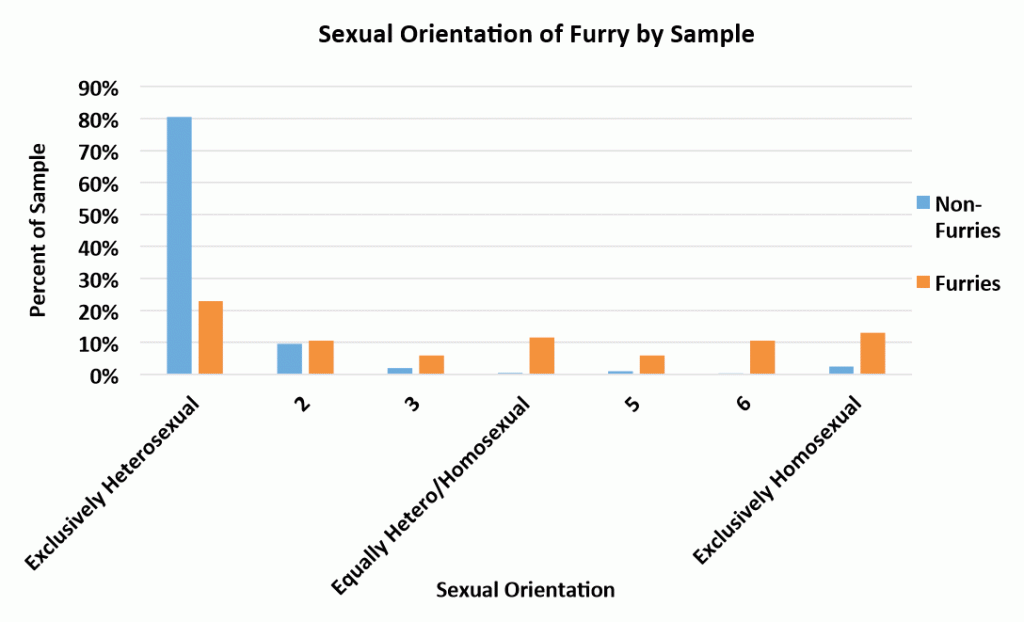
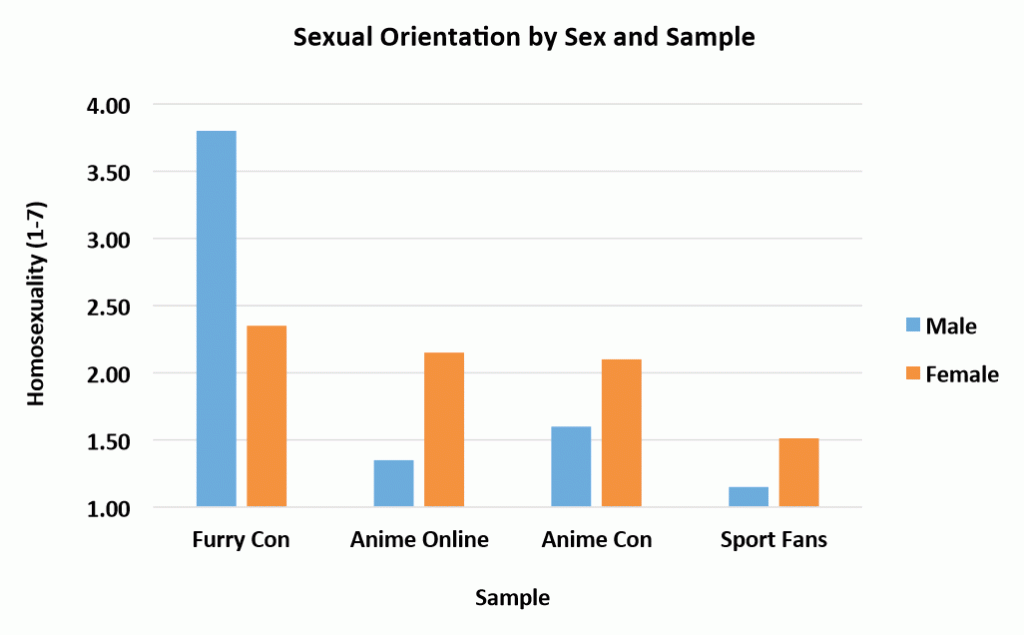
You said “Given that only about 20-30% of furries self-identify as exclusively or predominantly heterosexual, it may be possible that they construe themselves as a minority within the furry fandom (in fact, this is not the case, as they still make up the single-largest sexual orientation group within the fandom).” but the charts literally show that bisexuals and gays are literally larger.
Thanks for catching the typo! You’re right! It’s been fixed to better reflect the data. Thanks, again!
I’m a straight furry and I’m a little confused. A lot of people’s say that if you want to be a furry you must to be gay. I love to be a furry but I’m heterosexual. I think that if I am heterosexual I cannot be a furry. I don’t know. You are saying that I can be a furry even if I am straight? Thank you.
“A lot of people say” a lot of things, based on nothing but other things a lot of other people say, do, read, misunderstand, or fabricate. That’s why Furscience is made up of scientists who actually study furries, use real data, and publish actual peer-reviewed studies. Your sexual orientation doesn’t preclude you from being a furry. Start here: https://staging.furscience.com/whats-a-furry/
My name is A. Bayu Satrio. I am a final semester college student, currently working on a thesis on the furry fandom in general. And I have a question related to one of your reports on LGBTI+ representation, or should I say participation, in the fandom.
In The Fandom documentary that the team participated with Ash Coyote, there’s one scene saying “according to the AC2018 study approx. 80% of furries identifies themselves as LGBT+”.
Regarding this issue, I found quite a difficulty in calculating or explaining that percentage while reading the data given in the orientation section of the AnthroCon 2018 report. This is because when i add the numbers up, they did not match. Since I fear there might be miscalculations on my part, I might require a somewhat detailed numbers and explanation on this part.
Before I end this question, I personally would like to express my gratitude on how helpful the works made by the furscience team as the basis for my thesis. That is all, I expect a quick response from the team, and many thanks for the help.
Thanks for the compliment! Regarding your issue: can you send the link to the specific video with the time stamp of the data you’re questioning?
If I am correct it’s on the 00:44:30 to 00:45:00 mark.
Thanks for the timestamp. Can you send the link to the actual doc in question to admin@furscience.com ?
Dr Roberts is under the impression that she clarified this by email for you. We’re not sure where the numbers you’re citing came from or the context in which they were used, but we typically find about 25% of furries identify as straight, leaving 75% as LGB, asexual, and unsure.
I have a question about the LGBT representation. The Fandom documentary said that according to your AC2018 poll around 80% of furry fandom population (or attendees) are from LGBT circle. Where and how did the team got this number? I tried calculating it but could not get the exact figure and bit confused.